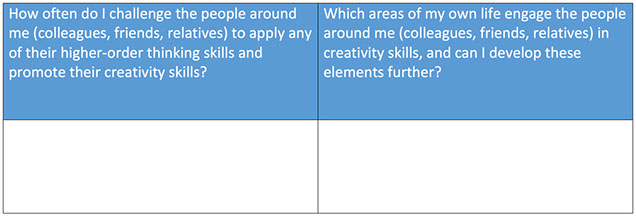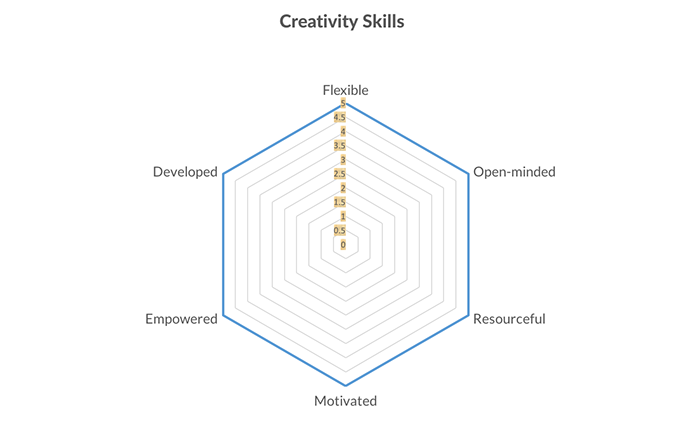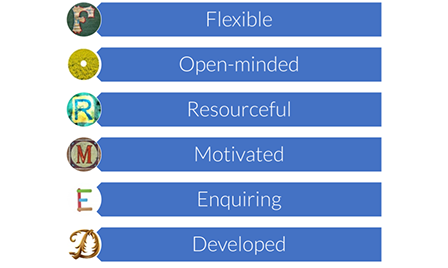Otermans Institute
at Hillwood Academy, Uttarakhand, India
Maria Spanoudaki
Contributor, Otermans Institute
Doctoral Researcher, Brunel University London
Owner and Director, Spanoudaki Language Schools Greece
Related lessons
Some of our free lessons that you should learn after completing this lesson.
• Ideation
What are Creativity Skills
• How can creative skills promote job opportunities
• How to develop my creativity skills
• The six thinking hats technique
• Tips on how to be creative during the lockdown
• Tips & Exercises for the 'lockdown'
Along with skills for life, learning and work, creativity skills are part of each individual’s personality. We all get excited when we come up with a good idea, find a solution to a problem or feel inspired to find new and practical ways to tackle regular situations. Everyone is creative to their own extent and has the potential to develop this skill further. That’s what creativity is all about. When creativity is embodied with an enterprising outlook, it enables us to learn, achieve and face challenges confidently throughout all aspects of our lives.
Therefore, we all use our creativity to solve problems, make decisions and resolve situations everyday. We sometimes do this subconsciously and other times consciously by handling challenges or tasks in our life or work. Creativity is a skill that is highly appreciated by employers, enterprises and international organisations. It helps individuals to be positive, flexible and open to new challenges. Combined with employability skills such as team work, communication, leadership, critical thinking and problem-solving, creativity enables us to succeed in our careers and is highly sought after by employers.
By adopting a creative and enterprising way of thinking and acting, you become confident because creativity can be FORMED. This projects the six main characteristics of creativity: Flexible, Open-minded, Resourceful, Motivated, Enquiring and Developed. You will explore this later in the first exercise of this lesson.
If you thought our content was useful and helped you upscale today, you can leave a donation at the below. All funds collected will be donated to the Prime Minister's National Relief Fund to support Covid-19 victims.
DONATE NOW
How can creative skills promote job opportunities
It is crucial, though, to identify creativity skills, so as to recognise them and develop them. They do not only involve the expressive arts but can be extended across all subjects and sectors and at any stage. Creativity skills can be applied in almost any context and can uncover new opportunities.
Creativity skills are essential for employment and central to the creative industries. It offers career options in games design, architecture, textile design, museums, advertising and media. In the ‘Skills of the Future report’ from NESTA, it is predicted that creativity will be the sharpest rising skill set across all industries in the next decade, with 58% of employers expecting this.
Universally, creativity is recognised as a core skill set by everyone, including the United Nations. Employers look for potential employees to be confident, resilient, entrepreneurial, with flexibility and adaptability, who can ask the right questions and take the initiative. Job security is enhanced when creativity skills are involved because they offer future-proof opportunities, and they are not likely to be replaced by robotics or computers; at least not anytime soon. This means the need for creativity skills will characterize more of the top jobs globally.
All work environments involve technical skills and factual knowledge. These are useful, but they do not always challenge us to utilise our creativity skills or try to promote a creative process. Making most of our Higher Order Thinking Skills, as elaborated in the diagram below, in order to design, invent, explore, synthesize, experiment and lead in our workplace, means that we make the most of our ability to develop our creativity skills in a highly engaging way.
How to develop my creativity skills
All human beings are born with a robust set of creativity skills. Babies and young children demonstrate a seemingly boundless capacity for curiosity, open-mindedness, imagination and problem-solving. However, these skills are often overlooked or even blocked off. Curiosity can be replaced by familiarity; open-mindedness by a fixed understanding of the world; imagination by tried and tested thinking and active problem solving by helplessness and apathy.
To unveil, promote and strengthen creativity skills, one has to follow specific steps:
1. Understand them.
2. Recognise them.
3. Celebrate them.
When we recognise the creativity skills in ourselves, we can focus on them. This, in turn, empowers us to utilise them more often, in more places, and in more ways. We, then, have the opportunity to practice, develop, and strengthen them. They can be seen as a range of tools that we can use to help ourselves unveil our potential. Getting success through creativity also gives us joy and something to celebrate; boosting productivity and more creativity.
The six thinking hats technique | Added separately by trainers of Otermans Institute
This is a simple yet useful method of boosting your creativity. The six hats technique is traditionally a simple decision making structure that according to Otermans Institute also allows for effective creativity by aiding in identifying and recognising relevant points and improving creative brainstorms. It efficiently distributes six important aspects of a creative process that help shape the creative idea and define and improve the output.
In this exercise, every hat provides a purpose in the creative process and is used separately to generate a single final result. You can designate team members with a coloured hat each, or if doing it individually, you only allow yourself to think in accordance with the hat you are wearing at any particular time of the creative process.
Blue hat sets the agenda and creative spirit. When wearing this hat, you should simply outline what you or the group originally set to create and define it.
White hat is a neutral hat and should be used to simply find and point out relevant facts and information that might be useful based on the outline of the creative project created through the blue hat.
Red hat coveys emotions and donning it allows a person to go with their gut creative feeling and unlike the white hat, to be emotional in creative decision making.
Black hat symbolises caution and is used to generate critical view points on ideas generated through the red and blue hats. This enables evaluation of the creative process and potential output to remove doubts and potential errors which improves efficiency.
Yellow hat symbolises positivity and helps balance the cautiousness of the black hat. It is used to determine and finalise the values of the ideas created by the red hat and evaluated by the black hat.
Green hat is perhaps the most important in creativity and it allows for generating new ideas, brainstorming and providing new directions to ideas previously determined by the hats. This hat can be used at any stage of the process and is highly versatile.
Tips on how to be creative during the 'lockdown'
Just START with something!
It’s time you fill the white space on a page, any page. Any form of language, written, spoken, played, delivered by you, exists because of you. You are, and you create!
Remember that we are All creative!
COVID-19 has forced most people to change their everyday lives overnight. However hard this is, we manage. We use our ability to adapt and make creative responses. Go ahead and direct this ability for yourselves.
Get inspiration from artistic models!
We learn by experience, and so we can learn from the great works of others. For example, Jim Morrison of The Doors read poetry and novels in order to write great songs. The Beatles learnt lyric writing from Bob Dylan but taught everyone else the art of pop songs. So, we can use this time in 'lockdown' to learn from ‘the best that has been thought and done’.
Isolation can be an opportunity for creativity!
We all need a space for creativity to blossom in our lives. Luckily, nowadays we have the biggest library at our disposal, which is the Internet. We just need the discipline, time and space to create. Through the Internet, we can learn to sharpen our creativity skills. Our minds and our lives are a palace of ideas from which we can withdraw anytime. The trick of the creative person is to capture these ideas and act upon them. A lyric scribbled on the back of an envelope might be your next hit song or the beginning of a novel. Keep track of your ideas and bring them into your space.
Tips & Exercises for the 'lockdown'
Self:
Activity 1: Use your creativity skills to fill in the ‘FORMED’ table, including words that describe the potential characteristics of your creative personality.

Activity 2: Try to answer these questions to get an insight into whether and how you use your higher-order thinking skills in your everyday life.

Activity 3: Use your self-reflective skills to consider your strengths against the six creativity skills we proposed with the acronym ‘FORMED’ around the spider diagram. You can make a mark/dot against them, with 5 being the strongest and 1 being the weakest. Finally, you can connect the marks/dots to create a shape that will indicate your strength and balance of your creativity skills visually.

Activity 4: To consolidate the learning experience of our material on Creativity Skills, you could use creative learning to enrich it and make it more challenging by answering the following questions that relate to ‘FORMED’, as described earlier:

Family: Do activity 1,2, 3 and 4 with your family or people you are living with during the 'lock down'. Once completed, everyone should share their own results with the group and discuss each other's creative personalities. Based on this you can also start a project as taught in our Open Source lesson where tasks are divided as per everyone's creative skill sets.
Don’t forget to ask us at Otermans Institute for more suggestions and tips using the form below. We would also love to hear your goals and how you are aiming to achieve them through the same form or via email on lessonsforhumanityqanda@gmail.com
Got queries regarding this article, or want to learn more?
Write to us, and our trainers will get back to you.
Powered by Smatter | Design support by NUTS India
